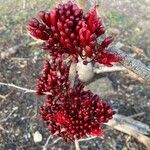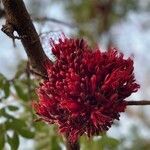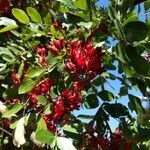Briefly deciduous, a tree up to 16 m in height, with a rounded crown and branches that hang down and turn upwards at the end. Bark: brown or brownish grey and rough. Leaves: rachis flattened and can be grooved above or slightly winged, with 4-7 (occasionally 8) pairs of opposite or sub-opposite leaflets; leaflets oblong to ovate-oblong or more or less rectangular, often asymmetric, with or without sparse hairs, 2.5-8.5 x 1.2-4.5 cm, the end leaflets being the largest; apex rounded, often notched; base rounded, asymmetric; margin entire, wavy; petiolules short, up to 2 mm or absent; petiole 0.5-2.5 cm long. Flowers: deep red, with slender, pink petals up to 1.5 cm long that are sometimes reduced or absent; stamens joined at the base; in dense, branched heads or panicles, 6-13 cm long; copious nectar is produced. Fruit: a flattened, woody pod, usually 6-10 cm long, with the characteristic persistent rim. Seeds: ovoid, flattened, pale brown, about 2 cm in diameter, with a large, conspicuous yellow aril.
A wide spreading tree. It grows up to 15 m tall. The trunk can be 60 cm across. The bark in young trees is smooth and brown but becomes rough in mature trees. The leaves are smooth or hairy. They leaves are 17 cm long by 8 cm wide. They have a leafy structure (stipule) at the base. The leaves are composed of 4-7 pairs of oblong leaflets. The leaflets have lopsided bases. The upper leaflets are the largest. The flowers are crimson and cup shaped. The flowers face upwards and are filled with nectar. This nectar is edible. It is the sepals and stamen, not the petals that make up the attractive flower. The flowers are produced on the old wood. The pods are brown and 12 cm long by 5 cm wide. They contain 6 light brown seeds. These have a lime green layer (aril) over one end. The seeds are edible after roasting.
Leaves paripinnate (occasionally imparipinnate); stipules narrowly triangular, 5 × 1.5 mm, early caducous; petiole 1.2–2 cm long, sparsely pubescent at first, glabrescent; rachis 3.5–17.5 cm long, sparsely pubescent at first, glabrescent, terete, furrowed, at most very narrowly winged; leaflets opposite to subopposite, in (3)4–6(7) pairs, 2.5–6.5 × 1.0–3.2 cm, elliptic to rhombic-elliptic or rhombic-ovate, often asymmetric, apex rounded or retuse (mucronate in very young developing leaves), base cuneate, pubescent to glabrous, glabrescent; venation slightly prominent on both surfaces.
Tree, up to 16 m high; crown rounded. Bark rough or smooth, greyish to reddish brown. Branchlets glabrous to shortly pubescent. Leaflets 4-7(8) pairs, opposite to subopposite, sessile or petiolate, base acute, apex rounded to emarginate, upper leaflets largest. Inflorescence a dense, congested, subglobose panicle, usually cauliflorous on older branches. Flowers deep red or scarlet. Calyx coriaceous; tube subcampanulate, sparingly pubescent; lobes 4, subequal, ovate-elliptic. Petals reduced to linear filaments. Flowering time Aug.-Nov.
Inflorescences often cauliflorous on the older wood, paniculate, congested; axis puberulous; flowers deep red or scarlet; bracts c.2.5 × 2 mm, broadly ovate-elliptic, concave, puberulous; bracteoles paired, c.3 × 2 mm, broadly elliptic, puberulous; bracts and bracteoles early caducous leaving prominent raised scars; pedicel 3–5 mm long, glabrous or puberulous.
Tree, up to 16 m high. Petals all, or some, reduced to linear filaments. Inflorescence usually a dense congested subglobose panicle, usually cauliflorous on older branches but occasionally terminal. Flowers maroon.
Pod 10–17 × 3.5–4.5 cm, oblong, flattened, glabrous, with numerous small resin-filled vesicles in the pod wall, several-seeded, tardily dehiscent leaving the dorsal and ventral sutures attached to the pedicel.
Ovary c.10 × 3 mm, narrowly elliptic, flattened, glabrous but verrucose near the margins; stipe c.3 mm long; style c.9 mm long, glabrous, stigma capitate, papillose.
Tree.. Leaflets 4–7 pairs, rounded to emarginate at apex.. Flowers deep red, in congested panicles.. Pods oblong, containing seeds with a large yellow aril.
Petals absent or reduced to one or more strap-shaped rudiments 2–3 mm long, or 1–4 normal, narrowly obovate, clawed, up to 1.8 × 0.6 cm.
Calyx lobes 4, ovate, 8–11 × 4–6 mm, gland-dotted and glabrous to sparsely pubescent outside, mainly towards the base, glabrous inside.
Seeds pale brown, 15–20 × 10–15 mm, broadly elliptic to rhomboid, flattened, smooth; aril 0.9–1.2 cm long, cup-shaped, basal, yellow.
Stamens 10; filaments c.17–19 mm long, expanded and fused in the basal 2–3 mm, glabrous; anthers dorsifixed.
Hypanthium 3–5 mm long, glabrous or pubescent especially on the ridges.
Branchlets dark brown, smooth, puberulous, glabrescent.
Tree, (5)10–15 m tall; bark dark grey-brown, furrowed.




